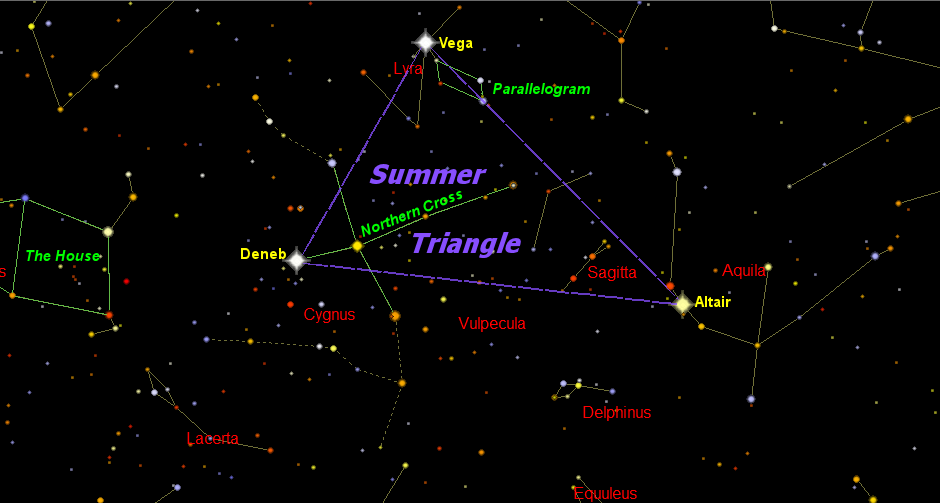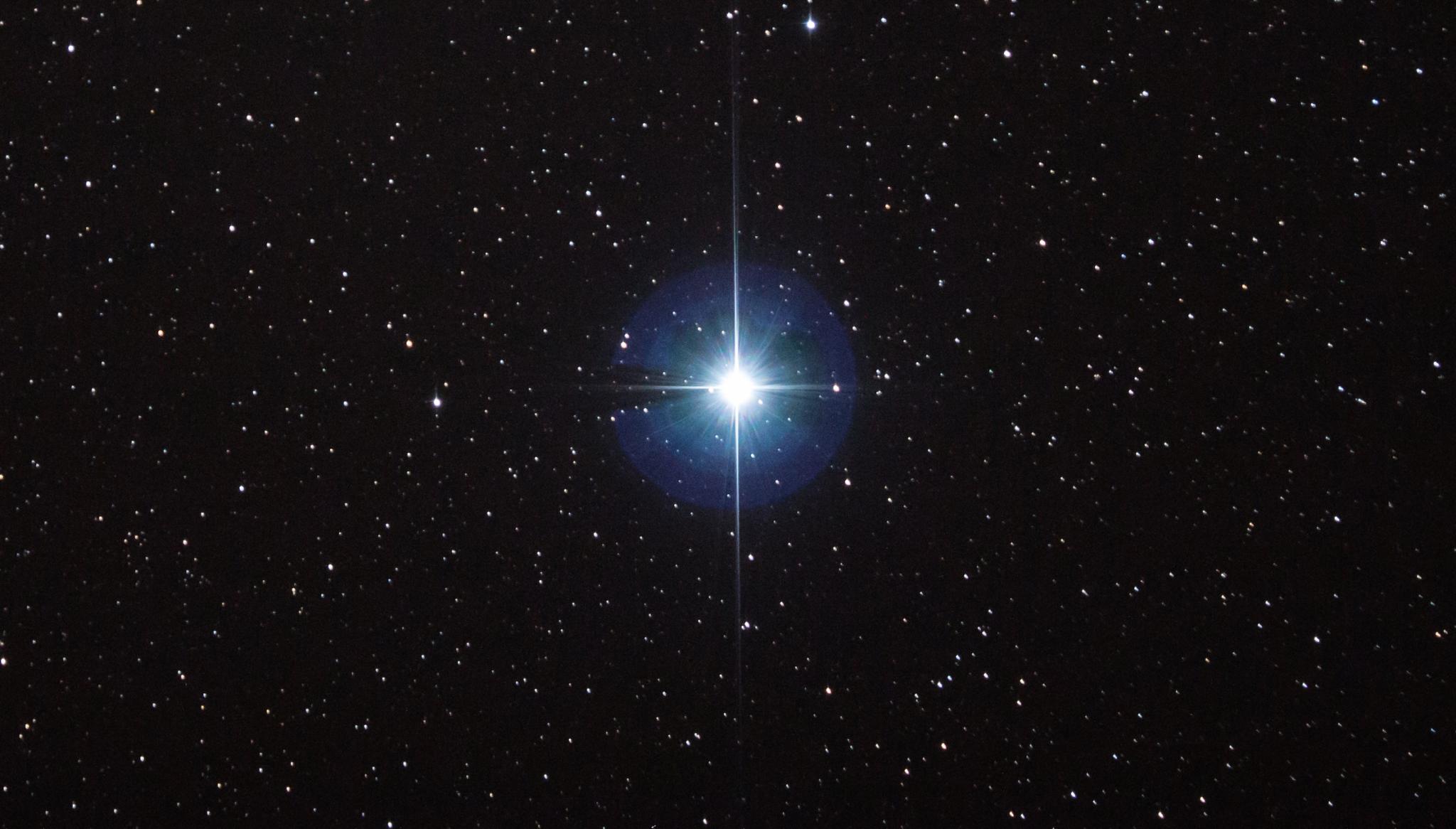In early summer, night falls at its latest hour—around 9:30 to 10 PM. High in the east shines summer’s bright star—the famous Vega. Learn fascinating facts about Vega, a favorite of stargazers and astronomers, and its fascinating folklore.
Away from city lights in mid-July, one could see as many as 2,500 naked-eye stars. But if you look east, only one star stands out because it’s the only bright star overhead—Vega.
1. Vega of The Summer Triangle
Vega is the 5th brightest star visible from Earth, and the 3rd brightest easily visible from mid-northern latitudes, after Sirius and the Arcturus. In the northern sky, it’s 2nd brightest after the red giant, Arcturus.
Vega is also one of three stars in the famous star pattern called the Summer Triangle, along with Deneb and Altair.

Learn more about the Summer Triangle.
2. Look Straight Up in July
Its high-up perch is a mere springboard. For those who live near latitude 40° (such as residents of Boston, New York, Denver, Philly, Indianapolis, or San Francisco), Vega is uniquely the only bright star that ascends to within a few degrees of the exact zenith. Straight up. On these summer nights, that happens at 1 AM. Or you can patiently wait for late September, when Vega hovers directly overhead at nightfall.

Vega, the Harp Star. Credit: CC image by Stephen Rahn via Wikimedia Commons.
3. How to Pronounce Vega
Most summer stars are dim and cursed with designations like HDE224334 or Zubeneschamali. Only a handful are brilliant and have popular names. Boasting the shortest name of any brilliant star, Vega is nonetheless routinely mispronounced as VAY-ga. That’s because few know this phonetics tip: star names are simple transliterations from their original language. They should be spoken as spelled. Orion’s brilliant foot is Rigel, pronounced RYE‘jl and Vega is really VEE-guh. No need to add a latin twist with VAY-ga and make it into a cigar or a Chevy. Originally it was WEE-ga, coming from an old Arabic word meaning a falling eagle. Indeed, in my antique astronomy books from the 18th century, the star is listed as Wega.
4. A Vegetarian Star?
People who eschew all animal foods call themselves Vegans, a term probably coined in the 1940s. But their ancestors were not Vegans who hailed from Vega, with its non-vegetarian “eagle” name. Despite being encircled by a dusty disk whose infrared signature has been interpreted as evidence of a planetary system, actual life is implausible there because of the star’s youth.
5. Vega Folklore
Interestingly, there’s a story about Vega and Altair. A number of Asian cultures have folklore surrounding these two stars, which is often some variation of the following: A celestial goddess falls in love with a mere mortal, but the goddess’ father forbids their union and it is doomed. However, the gods take pity and place the two lovers in the sky as Vega and Altair. Separated by a celestial river, the Milky Way, these star-crossed lovers are only allowed to reunite once year. They cross a bridge of magpies across the Milky Way on the 7th night of the 7th Moon.
Vega is also called the Harp Star since it’s in the constellation of Lyra, the Harp. According to Greek myth, the musician Orpheus played the harp to entrance both god and moral.

6. Vega is How We Measure Brightness
Shining at a steady magnitude zero, Vega serves as the “standard candle” used by the worldwide astronomical community to calibrate the brightness of everything else in the universe. Like the French bar of platinum that defined the meter until recently, Vega is the sky’s reference point for the magnitude system.
It’s an ideal choice because it displays not the slightest flickering or unsteady habit; it’s also a single star like our Sun, instead of a binary like most. Its brilliance, equal to 58 suns, emanates from a dazzling 2.7 million-mile-in-diameter ball with a surface of nearly pure hydrogen, floating at the relatively nearby perch of 25 lightyears.
7. Why is Vega So Bright?
Vega is more than 40 times brighter than our Sun! It’s twice the size and mass of the Sun. And it’s fairly close to Earth (for a star)—just 25 light-years away. Its nearness is the main reason why Vega is so bright.
8. Why is Vega Blue?
Why is Vega blueish in color? Its surface temperature is nearly 17,000 degrees Fahrenheit, making it about 7,000 degrees hotter than our Sun.
9. The North Star of Past and Future
Vega is not as normal as we once thought. In 1994, a team of Canadian astronomers announced that Vega has unsuspected peculiarities. It spins much faster than anyone imagined, in a giddy 11 hours compared to 25 days for our own Sun. And its pole of rotation is pointed straight toward us, give or take five degrees. For any Vegans looking skyward, our Sun is its north star!
Twelve thousand years from now, we’ll return the favor. Vega periodically becomes our own pole star as Earth’s axis wobbles through its 26-millennium precession. Brightest of all north stars through the eons, it nonetheless misses the celestial pole by four degrees, making it nearly ten times less precise than the current one, Polaris.
10. Earth is Traveling Towards Vega!
As if this weren’t enough to keep us interested, Vega marks the approximate direction toward which we travel in space. As our entire starry neighborhood participates in the galaxy’s grand rotation, we do a little nine mile-per-second sideslip in Vega’s direction. Those who mistakenly think that the whole universe races away from us might take a glance overhead. In a cosmos where the redshift is as common as pizza, this diamond at the zenith displays the much rarer blueshift.
So enjoy Vega right now as it hovers overhead near the zenith. But no need to rush. Vega will only grow brighter as it heads our way, keeping our descendants company through the eons.
→ See our Star Map with Vega and the Summer Triangle.












